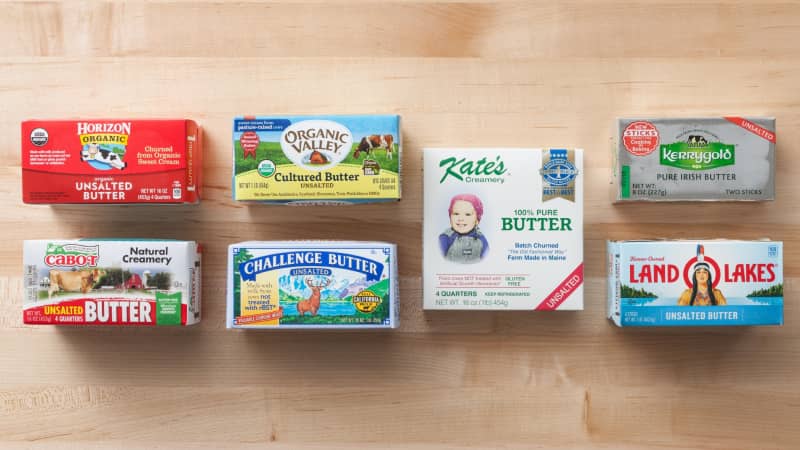Stand Mixers (High-End)
Equipment Review
For everyday cooking and baking, which unsalted butter is best? We tested seven supermarket products to find a new favorite.
Published Nov. 1, 2018. Appears in America's Test Kitchen TV Season 19: Updated Italian

In the test kitchen, we go through 30 to 40 pounds of unsalted butter a week as we bake cakes and cookies, make frostings and pancake batter, and cook pan sauces, roast chicken, and sautéed vegetables. We use unsalted butter almost exclusively because the sodium level of the salted stuff can vary and we prefer to control the seasoning of our food.
But which unsalted butter is best? A few years ago, we decided it was Plugrá, a high-fat product with a luscious texture. At almost $12 a pound, though, it's expensive. Although Plugrá is sometimes worth the splurge, we wanted a butter that was affordable and convenient for everyday use.
We assembled seven national top sellers, priced from $4.49 to $7.58 per pound. Two were cultured, which means that flavorful bacterial cultures were added during production, and one of these butters was imported from Europe. The rest were domestic “sweet cream” butters. All were purchased in the user-friendly format familiar in America: individually wrapped ¼-pound sticks, sold in packs of two or four. All but one product had measurement markings right on the sticks; the outlier had markings on the box. Tasters sampled the butters in three blind tastings: plain, in pound cake, and in sugar cookies.
To better understand our lineup, we first looked at how butter is made. Although it can be churned by hand, our butters were all made using industrial equipment. According to Better Butter (2012), a technical manual by Robert Bradley of the University of Wisconsin's Center for Dairy Research, it looks something like this: A tanker truck of cream arrives at the factory. The cream is tested and pasteurized. It's then tempered, a complicated process of raising and lowering the temperature that alters the structure of the cream's fat globules so the cream can be churned more effectively. In the production of cultured butter, the bacterial cultures are added at this point.
Next, during churning, the cream crashes down on itself with enough force to burst the membranes that surround the fat globules and help keep them separate. The bits of fat begin to clump together, eventually forming a solid mass of butter. The liquid (now buttermilk) is drained, and then the butter is rinsed. At this point, additional ingredients may be added, including preservatives such as salt for salted butter and lactic acid for most unsalted butters. The butter is “worked,” or kneaded, to incorporate the salt or lactic acid and to remove moisture. Once it's cohesive and has the desired moisture level, it is portioned and packaged.
We were pleased with the quality of the butters...
The mission of America’s Test Kitchen Reviews is to find the best equipment and ingredients for the home cook through rigorous, hands-on testing.

Kate is a deputy editor for ATK Reviews. She's a culinary school graduate and former line cook and cheesemonger.

This is a members' feature.